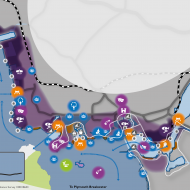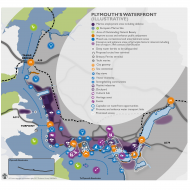PLY20 - Managing and enhancing Plymouth’s waterfront
The Plymouth and South West Devon Joint Local Plan has now been adopted! To find out more please visit the Plymouth and South West Devon Joint Local Plan: Adoption page.
Visit the interactive Plymouth Plan to see other policies that affect decision making across Plymouth City including the Council and its partners.
Plymouth's waterfront will be renewed, enhanced and maintained as Plymouth's showcase and as a unique, sustainable and vibrant asset that drives the city's economic, cultural, social and environmental wellbeing. This will be achieved by:
- Adopting an integrated coastal management approach that considers the land-sea planning interface, has regard for the range of activities in the coastal zone, gives priority to development that requires close proximity to the sea, improves connectivity, delivers community benefits, and protects and enhances the high quality marine environment and seascape. In the longer term, the City will work with the Marine Management Organisation and its Tamar Estuaries Consultative Forum partners to shape the South West Inshore Marine Plan to ensure it delivers integrated marine and terrestrial planning for Plymouth.
- Improving key waterfront destinations, assets and opportunities, through a strategic approach which ensures that the waterfront's potential is fulfilled as the centrepiece of the Mayflower 400 celebrations, a regional visitor economy hub and a high quality place for the local community to enjoy. This includes:
- Strengthening the role of The Barbican and Sutton Harbour as a unique and vibrant historic city quarter, with a focus on high quality mixed use and heritage-led regeneration, a prime location for the fishing industry as well as water based leisure and events, and high quality urban living and employment.
- Protecting and enhancing The Hoe's unique man-made and natural heritage and using development and public realm measures proactively to repair damaged environments, re-use historic buildings and enhance the overall enjoyment of the area by visitors and residents.
- Enhancing Millbay as an attractive international gateway and cultural destination, incorporating space for marine events, a new cruise ship terminal and European ferry link, with major waterfront regeneration.
- Supporting the continued regeneration and restoration of Royal William Yard as a vibrant heritage-led residential community and cultural destination.
- Delivering major improvements to the connecting routes for all modes of transport between the City Centre and waterfront, including through Bretonside and along Armada Way, and a new boulevard to Millbay.
- Delivering distinctive, high quality and accessible places along the waterfront through:
- Delivering high quality and integrated public realm improvements, including public art, as well as making good use of waterfront public spaces, cultural events and festivals.
- Ensuring that waterfront development is of high quality design, safeguards the waterfront's primary functions, improves use of and access to underused waterfront sites, and supports the regeneration of waterfront communities.
- Ensuring opportunities to enable high quality public access to the water for formal sport and active recreation are identified and delivered.
- Safeguarding and providing opportunities for improved access to water transport along Plymouth's waterfront.
- Protecting iconic and historic landscapes and green space sites that enable a visual and physical connection to the water environment, and seascapes and views that define the city, whilst enhancing the relationship between Plymouth and the surrounding landscapes that provide its enviable setting.
- Safeguarding and further enhancing public access to and along the waterfront and water access points, providing increased opportunity for enjoyment of the marine environment for residents and visitors alike.
- Safeguarding and enhancing the natural environment including the delivery of the conservation objectives for the Plymouth Sound and Estuaries European Marine Site.
- Conserving and realising greater benefits from the waterfront's history, including the city's naval heritage and its marine archaeology.
- Safeguarding the port functions and the area’s key role in providing key infrastructure and land to support the priority marine employment sector, particularly for those sites with deep water berths. This will include defence, port, fishing, marine industries and research, and marine recreation.
- Using development and technological solutions through the planning process in order to minimise the risk of hazardous installations at Cattedown port and to increase the opportunity for new economic and other development in the Cattedown area.
- Ensuring that development is resilient, responds to the challenges of climate change and protects the Plymouth Sound and Estuaries European Marine Site from pollution. This will be achieved through providing where appropriate to the site, improvements to surface water drainage systems, future connection to critical drainage infrastructure and district heat networks relevant to the site, delivering flood protection measures, and/or contributing proportionately to strategic flood risk management measures in line with local strategies where they exist.



